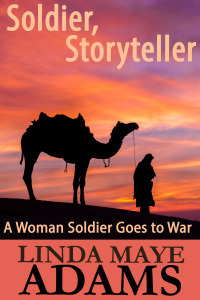Linda Maye Adams's Blog, page 94
September 7, 2015
Ahoy to the Navy in Japan
A Navy ship arriving in Japan gives us this picture of a military woman at work:
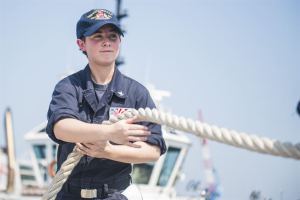
U.S. Navy Petty Officer 3rd Class Abby Thomas heaves a mooring line as the guided-missile destroyer USS Fitzgerald arrives at Commander Fleet Activities Yokosuka in Yokosuka, Japan, Aug. 3, 2015.
Photos of the ship she was on are here, including one of the ship in dry dock.
—
I worked in a Joint Service company. We worked with all the services, and most were easy to get along with (except the Air Force). But not everything translated across the services. Everyone had their own “rice bowl,” and the Navy’s enlisted rank designations were nearly unintelligible to the Army folks. It seemed to be one of those things where you had to be there in the Navy to understand it, though I suppose they thought the same thing about our rank!
Filed under: Military, Photos Tagged: Military Women, Navy Women








September 6, 2015
Weekend Musings: Exercise
It’s now been about seven, eight weeks, but I’ve started exercising more again. Beyond walking anyway. It started with Me-TV, of all things, and Facebook. They posted an advertisement for Jack La Lanne’s show that they would be airing online.
I had vague memories of the show, so I tuned in. And I’m watching this show and going, “I could do this,” and I started doing it and it was kind of fun. I could also see a change right away.
I’ve always had a bad history with physical exercise. I have flat feet, which are hereditary in my family. In my case, my feet roll in when I walk, and then drop all the way to ground. It makes for bad running, or anything else involving the feet.
In 7th grade they had the bean run. We’d run around the exercise field and when we passed the teacher, she’d give us an uncooked pinto bean. The more times we ran around in the allotted time, the more beans we got, and then afterwards everyone would count them up.
I was always the last one in and the one with the fewest beans.
That trend continued in the Army, which absolutely loved running. The formation would take off fast, and I would try to keep up. But the faster I ran, the more clumsy I felt, like I was going to careen out of control and slam into the people around me.
The Army was also good at humiliating people for not keeping up. A lot of times, they treated us as if we were lazy or needed extra training. Extra training consisted of doing it more.
But it sometimes veered into cruel.
Some of the guys would make nasty remarks. One sergeant kept making such juvenile remarks to me that I ended up going to my squad leader to get him to stop.
And I also kept hurting myself trying to keep up, so I was really glad to stop when I got out of the Army.
But I’ve also felt the lack of exercise.
I’d tried the gym off and on over the years. But the weights got boring quickly, and time was always a factor. Who wants to get off work, then spend an hour driving back and forth to the gym? I’ve always liked the idea of the classes, but they tend to be very aggressive.
So trying Jack La Lanne’s exercises was a perfect fit for me because that focus is on using the muscle, and I don’t have to do any driving. Unfortunately, Me TV stopped posting the videos about four weeks ago. Given the abrupt nature, I think a legal issue cropped up. I started repeating the videos, but I got one of the books (thanks Amazon!).
My overall goal is to lose weight to help my feet, but right now the goal is just simply to do it and have fun doing it.
Filed under: Lifestyle, Military, Personal Tagged: Jack La Lanne, physical fitness, Physical Training








August 31, 2015
US Navy Presidential Ceremonial Honor Guard
Take a few minutes and watch this video of the Navy’s Presidential Ceremonial Honor Guard. This is the elite of drill and ceremonies for the military, and frankly, this is awesome.
—
Drill and ceremonies is not easy to learn. It starts with marching in basic training, and the drill sergeants have to tell the recruits to hold up their right hand because it’s easy to turn the wrong way. I always had a terrible time marching, so much so that it was what concerned leadership the most. I have absolutely no sense of timing–I’d invariably end up out of step with everyone else. I’d try watching the feet of the person in front of me, listen to the cadence caller, and if there was a drum, try to listen to that. Somehow the timing of it never translated well for me!
Filed under: Entertainment, Military Tagged: Honor Guard, U.S. Navy








August 30, 2015
5 Ways Pantsers are Different Than Outliners
NanoWrite’s coming up in a few months, and the discussion about pantsers (people who don’t outline) vs. outliners invariably comes up. I thought I’d discuss the 5 ways pantsers are different than outliners.
We often start a story, frankly, not knowing a whole lot.
For my current project Lightkeeper, I started with a character, a setting, and a cool piece of research that I’d run across. I’m not even sure if it’s fantasy or science fiction yet, and I have no clue how it will end.
We discover what the story is about by writing it.
I honestly don’t know how someone can map out the entire story in an outline without writing it first. So much of what I do is tied to things that come when I do the actual writing.
We write extra scenes or go off on tangents.
That’s part of the discovery and exploring of the story. Sometimes it’s important to try something, even if it doesn’t get used. When I started Lightkeeper, I tried a different main character. I wrote a few scenes, enjoyed them immensely, but it wasn’t the right main character for the story. But it did help develop part of the story that I’m currently using.
We’re writing along, and suddenly this cool surprise pops in, and it’s like “Where that’d come from?”
I like it when this happens because it’s often something awesome that I would have never thought of if I’d outlined, and it will always be something that makes the story less predictable.
Pantsing is lot like the reader’s experience.
The reader discovers the book by reading it word by word, scene by scene.
Any other differences you can think of?
Filed under: Books, Writing Tagged: main character, Pantsers








August 24, 2015
Rocking Women Army Rangers
This week, we had the historic first: Two women survived Ranger training. I’ve obviously never been to Ranger training–nor would I have wanted to–but I knew people who went through it. Not for the faint hearted.
Of course, it comes with an awesome action photo.
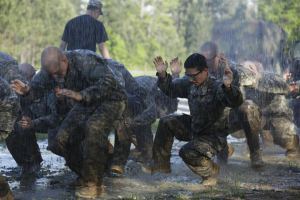
In this file photo, soldiers test their physical stamina during the Ranger Course on Fort Benning, Ga., April 21, 2015. Soldiers attend the course to learn additional leadership, and technical and tactical skills in a physically and mentally demanding, combat simulated environment. U.S. Army photo by Sgt. Paul Sale
—
My basic training was in New Jersey, starting about May (I was actually there in April, but we didn’t have enough women for a whole class). It was typical New Jersey weather–hot and humid. Lots of mosquitoes. The BDUs–similar to what you see in the photo except for the camo pattern–would get soaked through with sweat. The uniform is fine when it’s dry, but when it’s wet, it’s like wearing cardboard.
We were out on the range one day changing these big targets and soaked through with sweat. Just so hot out. Then it started to pour all of sudden, and we were out there, hands raised to the sky, because the rain felt so good!
Filed under: History, Military Tagged: Fort Benning, Fort Dix, Georgia, New Jersey, Women Rangers, Women Soldiers








Navy has the watch today
Back to the Navy again for another great photo (hear that Army, Air Force, and Marine Corps? Where are your women service members?!).
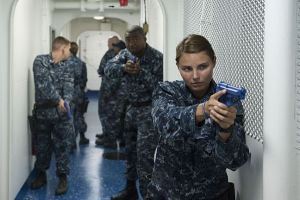
150812-N-UY393-367
SAN DIEGO (Aug. 12, 2015) Seaman Blythe Wallace, assigned to the amphibious assault ship USS America (LHA 6), executes a security simulation during Between the Lifelines (BTL) training aboard the barge. BTL is a two-week security training program that provides the fundamentals of watch standing and non-lethal weapons to Sailors. America is undergoing a post-shakedown availability (PSA) in which the ship’s crew and assigned contractors make improvements to the ship’s design. America’s PSA will pave the way for future America-class amphibious assault ships. (U.S. Navy photo by Mass Communication Specialist 3rd Class William Berksteiner/Released)
—
I never used a handgun when I was in the service. They were only for officers. All the enlisted soldiers were issued an M16A1 rifle. That thing was hard to carry around. It was about three feet long, which made it super easy to get into everything.
I’d hang the strap (called a sling) over my shoulder, and then as I walked the strap would slide down to my elbow, so now I had this stilt like thing banging into my leg. Pull the strap back up, and then it was back down on my elbow again a few minutes later.
Filed under: Military, Writing Tagged: M16 Rifle, Military Women








August 22, 2015
Soldier, Storyteller Available!
My Desert Storm book is finally out! I honestly didn’t expect this would happen. I knew I wanted to write a book about my experiences even a year after the war. But it was such a difficult subject to talk about that it took almost 25 years before I could actually write about it.
On August 2, 1990, Saddam Hussein invaded Kuwait. Within twenty-four hours, he controlled the entire country. Five days later, the United States was deploying soldiers and had named the military operation Desert Shield.
This would be the largest deployment of women at the time. Over 40,000 women went to war. It was so new that people questioned whether women should be there, and what would happen to the families they left behind.
Linda Maye Adams was one of those soldiers. Soldier, Storyteller is a rare inside look at war from a woman’s perspective.
Her memoir answers the question: “What was it like?”
Filed under: History, Military, Writing Tagged: Desert Storm, Women Soldiers, Women Veterans








August 17, 2015
Drill Sergeants–Respect Them and Hate Them
I had to work pretty hard to find this photo. I went through 15 pages of Air Force photos, and I could only find one of a woman that wasn’t very good. Fortunately, DOD did have the photo below, though it was the same problem–a lot of awesome photos, but women were nowhere to be found.
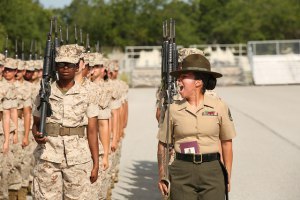 U.S. Air Force Airman 1st Class Ben Sedlacek, a KC-135 Stratotanker aircraft boom operator with the 350th Air Refueling Squadron, directs the boom to connect with approaching aircraft for midair refueling June 26, 2014, during Red Flag-Alaska 14-2 at Eielson Air Force Base, Alaska. Red Flag-Alaska is a series of Pacific Air Forces commander-directed field training exercises for U.S. and partner nation forces, providing combined offensive counter-air, interdiction, close air support, and large force employment training in a simulated combat environment. (DoD photo by Tech. Sgt. William Buchanan, U.S. Air National Guard/Released)
U.S. Air Force Airman 1st Class Ben Sedlacek, a KC-135 Stratotanker aircraft boom operator with the 350th Air Refueling Squadron, directs the boom to connect with approaching aircraft for midair refueling June 26, 2014, during Red Flag-Alaska 14-2 at Eielson Air Force Base, Alaska. Red Flag-Alaska is a series of Pacific Air Forces commander-directed field training exercises for U.S. and partner nation forces, providing combined offensive counter-air, interdiction, close air support, and large force employment training in a simulated combat environment. (DoD photo by Tech. Sgt. William Buchanan, U.S. Air National Guard/Released)
—
I had two male drill sergeants in Basic Training and one for the training. Both classes were all women.
It’s quite a shock getting off the bus, and these people are screaming at you. Their screaming prompted us to race off the bus, and then race up two or three flights of stairs in the barracks, and then race down the stairs again.
Even in the Mess Hall line, the drill sergeants stalked back and forth next to us in the line, telling us to hurry, hurry, hurry. We’d sit down and barely get the first fork in, and then the drill sergeant was screaming at us to go, so we’d be in line to turn the tray in and still gulping down all the food.
At one time, we saw the drill sergeant’s hat on the table, and we were like cats checking out something that we didn’t trust wouldn’t attack us. Of course, no one touched it.
But by the end of basic training, some of women were starting to imitate the drill sergeants, which was a shift in how we thought about them. We’d survived, and they’d helped.
Filed under: Military, Photos Tagged: Army, Basic Training, Marine Corps, Women Soldiers








August 14, 2015
Typos Should Not Be Drama Queens
On one of the writing Facebook pages I’m on, a ruckus has erupted—over typos. After a writer corrected another writer for the purpose of “learning,” the moderator stepped in and said to leave the grammar police out. The purpose was to make the place a safe zone.
Of course, that outraged several writers who thought it was their job to inform others of their typos so they would know they made them and supposedly learn not to do it. (They were banned.)
I was surprised at how much that brought back old feelings of frustration over typos. Not at making them. I know I make them.
But at how some people overreact to them.
I don’t have problems when someone flags one and says, “Hey, there’s a typo in paragraph 2.” I’m cool with that.
But I’ve also had a long history of run-ins of people who are very intolerant of typos. It’s like they’re looking to be a drama queen over something unimportant. There’s nothing worse that going over something 4-6 times, running spell check and doing a final check, and that person catches the one typo I missed and yells that I’m sloppy, incompetent … well, you get the idea.
Then there’s the lecturers, which is what prompted the moderator to speak. The lecturers see writer and puff themselves up, officious tone in hand. Obviously, that writer was not smart enough to realize she was making typos and needs someone to explain the error of her ways so she can learn how to not make them.
I had one pop in on the blog. A copy editor published a lecturing comment citing “numerous typos” in one post and sternly admonished that I needed to proofread. I use Dean Wesley Smith’s cycling method on everything I write, so it’s a constant back and forth. Then I spellcheck and proofread. I make a lot of typos, but I catch most of them. It’s still hard for me to let something go because I want to check it one or two more times for typos and make sure I didn’t miss any, though I know I will miss one.
So when I saw the comment, that old doubt caused by all the Typo Drama Queens popped up. Had I really missed that many? I was envisioning six for some reason.
The “numerous typos” was ONE typo. I’d flipped ‘or’ for ‘of,’ which is a hard one for me to spot.
I used to berate myself when someone else found a typo, wishing I could be better and wondering why I didn’t catch it. But one of my past jobs has largely broken me of that. I’ve seen a lot of paperwork with extremely embarrassing mistakes.
What’s your drama queen typo story?
Filed under: Thoughts, Writing Tagged: typos, writing fiction








August 12, 2015
Why You Shouldn’t Write for Free
I just saw this week a call for stories from veterans. Didn’t pay anything, and for that matter, didn’t even state the rights or what it would be published in. The implication, for this call anyway, was that it would be therapy.
I know a lot of people will look at the call and think it’s an opportunity to be heard, and the opposite is probably more likely to be true.
Because I used to think nothing of writing for a magazine that didn’t pay. Most of my early writing credits are non-paying, or at best, token. One of my primary reasons is because it gets passed around that you should build your writing credits by writing for free, or use it to get “exposure.”
And unfortunately, that’s a pretty big myth.
The exposure thing has a condescending quality to it, like writers are victims, and someone needs to feel sorry and help them. I’d see magazines say, “We don’t pay, but we’ll post your bio and link!” Said with a straight face.
If the magazine is selling on exposure, they’re marketing to writers, not readers. That says they don’t know what they’re doing.
The writing credits is a more troubling area because it really feels like success. Your story gets published, and you can show it off to people. I made the rounds and got a lot of stories published. One day I applied for membership in a writing organization.
Not one of those credits counted.
That was a big shock.
But there was a bigger one.
I remember going through the Short Story and Writer’s Market, looking at the percentages of acceptances. The high pay magazines received a large amount of submissions, but didn’t have a lot of acceptances. I’d see that and think it was too hard and go for the non-paying ones because the percentages were better.
And told myself, without realizing it, that I wasn’t good enough to get paid.
Free is sometimes has a pretty high cost.
Filed under: Writing Tagged: Short Stories, Writing credits, writing for free









